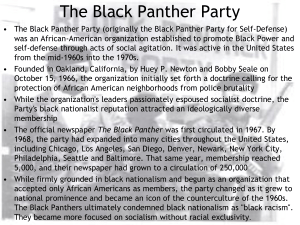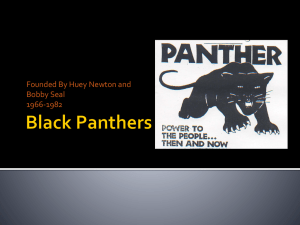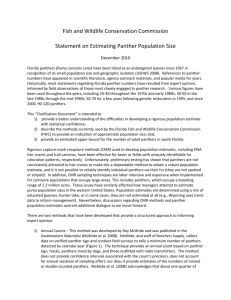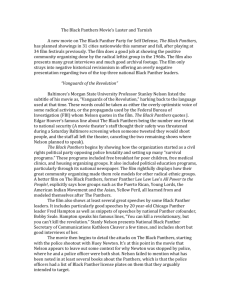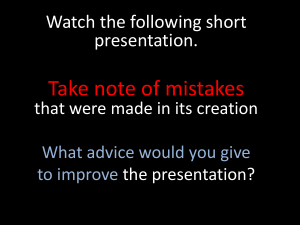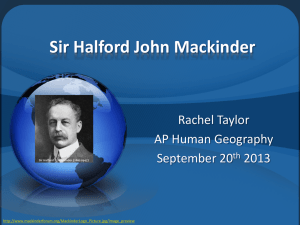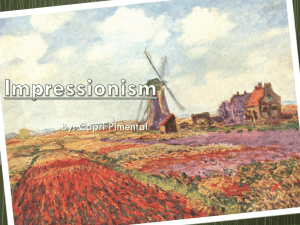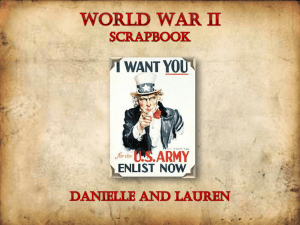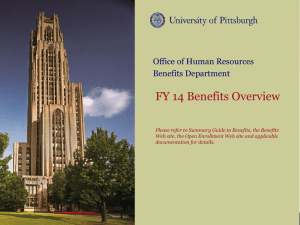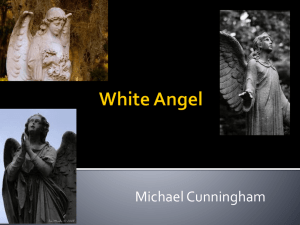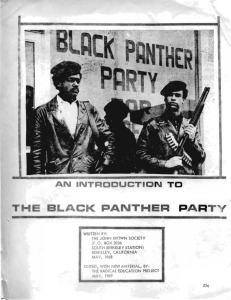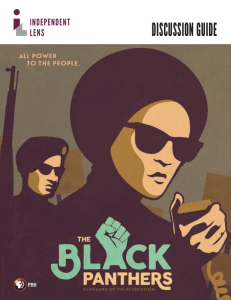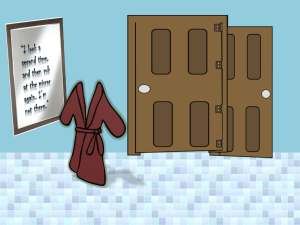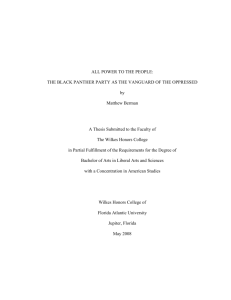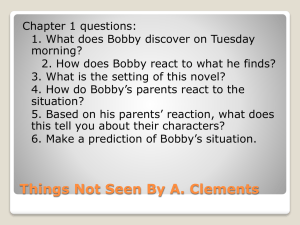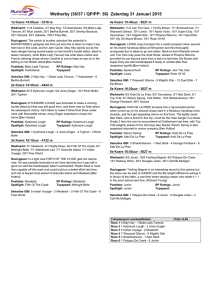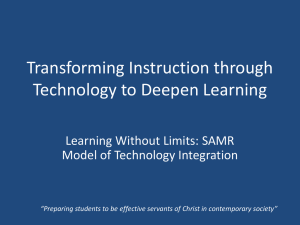Google Lit Trip
advertisement
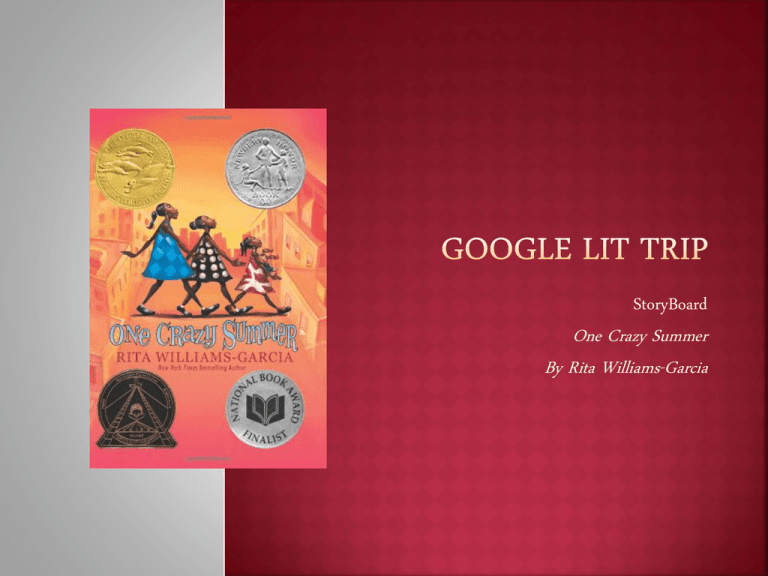
StoryBoard One Crazy Summer By Rita Williams-Garcia One Crazy Summer Set during one of the most tumultuous years in recent American history, One Crazy Summer is the heartbreaking, funny tale of three girls who travel to Oakland, California, in 1968 in search of the mother who abandoned them. The path taken by these three little girls in no coincindence. The following Google LitTrip will take the reader on a journey through the political and social unrest of the late 1960's, with a focus on events that played a pivotal role in the history of the United States. This LitTrip will be used to build appropriate background knowledge related to the racial climate of the 1960’s, as well as the Black Panther Party and its contributions to this decade. http://apathwaytonewworlds.file s.wordpress.com/2012/07/onecrazy-summer.jpg Bedford-Stuyvesant is a neighborhood in the central portion of the New York City borough of Brooklyn. For decades, it has been a cultural center for Brooklyn's black population. Following the construction of the subway line between Harlem and Bedford in 1936, African Americans left an overcrowded Harlem for more housing availability in Bedford-Stuyvesant. From Bedford-Stuyvesant, African Americans have since moved into the surrounding areas of Brooklyn, such as East New York, Crown Heights, Brownsville and Fort Greene. Brooklyn contains dozens of distinct neighborhoods, representing many of the major ethnic groups found within the New York City area. Bedford-Stuyvesant is home to one of the most famous African-American communities in the city, along with Brownsville and East New York. "BedStuy" is a hub for African-American culture, often referenced in hip hop and African-American art. http://upload.wikimedia.org/wikipedia/commons/t humb/d/d3/Greenpoint_Houses.JPG/800pxGreenpoint_Houses.JPG Sisters Delphine, Vonetta and Fern call Herkimer Street home. They live here with Big Ma (their grandmother) and their father, Papa. Six and a half hours had passed since we’d hugged Big Ma and kissed Pa at John F. Kennedy Airport. The clouds had made peace with our Boeing 727. It was safe to breathe. I stretched as far as my legs could go. (p.8) Reading Strategy Practice: Synthesizing Point-of-View is a method the author uses to tell a story. Sometimes an author tells a story in third-person, which means that the story is being told by a narrator explaining the characters thoughts, feelings and actions. When an author uses first-person point-of-view, the sotry is being told by one of the characters and the pronoun ‘I’ is used. Which point of view does the author use to tell this story? http://www.panynj.gov/photo/airports/jfkhistory-c.jpg How did you decide? Use examples from the book to support your opinion. Cassius Clay Clouds Reading Strategy Practice: Making Connections Good thing the plane had seat belts and we’d been strapped in tight before takeoff. Without them, that last jolt would have been enough to throw Vonetta into orbit and Fern across the aisle. Still, I anchored myself and my sisters best as I could to brace us for whatever came next. Those clouds weren’t through with us yet and dealt another Cassius Clay–left–and–a–right jab to the body of our Boeing 727. (p. 1). Who is Cassius Clay? Which literary device is being used in the paragraph? Why? http://upload.wikimedia.org/wikipedia/commons/ thumb/8/89/Muhammad_Ali_NYWTS.jpg/478pxMuhammad_Ali_NYWTS.jpg The video montage illustrates visually the events of the Detroit Riots of 1967. The 1967 Detroit riot, also known as the 12th Street riot, was a civil disturbance in Detroit, Michigan, US that began in the early morning hours of Sunday, July 23, 1967. The precipitating event was a police raid of an unlicensed, after-hours bar then known as a blind pig, on the corner of 12th (today Rosa Parks Boulevard) and Clairmount streets on the city's Near West Side. Police confrontations with patrons and observers on the street evolved into one of the deadliest and most destructive riots in United States history, lasting five days and surpassing the violence and property destruction of Detroit's 1943 race riot. To help end the disturbance, Governor George Romney ordered the Michigan National Guard into Detroit, and President Lyndon B. Johnson sent in Army troops. The result was 43 dead, 467 injured, over 7,200 arrests, and more than 2,000 buildings destroyed. The scale of the riot was surpassed only by the New York City Draft Riots, which took place during the U.S. Civil War, and the 1992 Los Angeles riots. The riot was prominently featured in the news media, with live television coverage, extensive newspaper reporting, and extensive stories in Time and Life magazines. The Detroit Free Press won a Pulitzer Prize for its coverage. Reading Strategy Practice: Questioning Do you think the extensive media coverage of the riots and other similar events played a role in the Civil Rights Movement? http://youtu.be/OZMCTQSVReM Do you think the coverage had a positive or negative effect in advancing the movement? On December 4th, 1969, Chicago police raided Fred Hampton's apartment and shot and killed him in his bed. He was just twenty-one years old. Black Panther leader Mark Clark was also killed in the raid. While authorities claimed the Panthers had opened fire on the police who were there to serve a search warrant for weapons, evidence later emerged that told a very different story: that the FBI, the Cook County States Attorneys office and the Chicago police conspired to assassinate Fred Hampton. This article, from the Chicago Tribune, describes the events that lead to the death of Fred Hampton, a prominent leader in the Black Panther Party for Self Defense. http://www.chicagotribune.com/news/politics/chichicagodays-pantherraid-story,0,3414208.story http://www.chicagotribune.com/media/photo/200809/42086758.jpg Click the link for a video detailing the government conspiracy against Fred Hampton, the Black Panther Party and other civil rights organizations throughout the 1960's. "http://youtu.be/5Ds7NDC2-SM Rachel Noel was the first African-American woman elected to public office in Colorado and the first African-American elected to the seven-member school board of the Denver Public Schools. Motivated by her own experience with discrimination, she seized the opportunity to work toward desegregating Denver’s schools. She introduced what became known as the Noel Resolution, which set a goal for total integration by December 1968. The method used to desegregate the schools was known as 'Desegregation busing' This method, also known as forced busing or simply busing, is the practice of assigning and transporting students to schools in such a manner as to redress prior racial segregation of schools, or to overcome the effects of residential segregation on local school demographics. Public opposition, including hate mail and angry phone calls, did not discourage her. Although the new school board overturned the resolution in 1969, the suit to integrate Denver schools was eventually upheld by the U.S. Supreme Court. Similar events occurred across the nation, some ending in violence. This was the case when 'bussing' was implemented in Boston in the early 1970's. View the video below, then answer the questions. Reading Strategy Practice: Making Connections List the reasons given by those on both sides of the issue (i.e. pro-bussing vs. anti-bussing). http://youtu.be/jRHbLS-6JNg Do you think 'bussing' is an effective tool to integrate schools? Why? Those clouds weren’t through with us yet and dealt another Cassius Clay–left–and–a–right jab to the body of our Boeing 727…it’s just the clouds bumping…Like they bumped over Detroit and Chicago and Denver. **Reading Strategy Practice: Inference Why do you think the author chose to mention those cities along the route to Oakland? http://www.historycentral.com/aviation/airports/national.jpg Secret Agent Mother/Green Stucco House It could have been the way the woman was dressed. Big black shades. Scarf tied around her head. Over the scarf, a big hat tilted down, the kind Pa wore with a suit. A pair of man’s pants… Cecile looked more like a secret agent than a mother. (p.18) There was something uncommon about Cecile. Eyes glommed onto her. Tall, dark brown woman in man’s pants whose face was half hidden by a scarf, hat, and big dark shades. She was like a colored movie star. Tall, mysterious, and on the run. Mata Hari in the airport. Except there weren’t any cameras or spies following the colored, broad-shouldered Mata Hari. (pp.19-20) Reading Skills Practice: Monitor Learning Do you know who Mata Hari is? If not, click the link below. Reading Skills Practice: Visualizing http://www.huduser.org/rbc/newsletter/images/o bispo.GIF http://www.biography.com/people/mata-hari-9402348 Can you get a mental picture of the girls’ mother? Draw a picture of what you think she might look like? Reading Skills Practice: Synthesizing Why do you think their mother seems so mysterious? Inseparable “If you girls want breakfast, go’n down to the People’s Center.” We said all together, “The People’s Center?”…Nothing but black folks in black clothes rapping revolution and a line of hungry black kids. (pp. 56-57) In January, 1969, the Free Breakfast for School Children Program was initiated at St. Augustine's Church in Oakland by the Black Panther Party. The Panthers would cook and serve food to the poor inner city youth of the area. Initially run out of a St. Augustine's Church in Oakland, the Program became so popular that by the end of the year, the Panthers set up kitchens in cities across the nation, feeding over 10,000 children every day before they went to school. At the street level the Black Panther Party began to develop a series of social programs to provide needed services to black and poor people, promoting thereby, at the same time, a model for an alternative, more humane social scheme. These programs, of which there came to be more than 45, were eventually referred to as Survival Programs, and were operated by Party members under the slogan "survival pending revolution.“ http://youtu.be/RuDncGcURzA http://www.jetcityorange.com/blackpanther-party/breakfast-program.jpg According to the interview, what were some of the other “Survival Programs” that the Black Panther Party implement in the community? This is the site of one of many rallies held by the Black Panther Party to spread their message of Black Pride and empowerment for Black people. In this speech, Bobby Seale outlines the “basic platform” of the Black Panther Party. The Ten Point Program was the foundation for the work of the Panthers throughout the United States. Click the link to view the Ten Point Program Reading Strategy Practice: Inference http://youtu.be/LPP0hiLuxdQ http://s3.amazonaws.com/rapgenius/131 2902177_BlackPantherParty10pointPlatfor mand.jpg After listening to the speech and gaining insight as to the goals of the party, is the Black Panther Party portrayed accurately in the media? Rally For Bobby When Sister Pat pinned the picture of Bobby Hutton to the wall next to the other revolutionaries I learned who he was. I finally read about him in the Black Panther newspaper. The article reported how the people wanted to name the park after Bobby. The article also retold what had happened to him. I kind of remembered having watched the news with Big Ma a few months ago and hearing about the shooting in Oakland. Now the shooting seemed closer. More real. Bobby Hutton was the first member of the Black Panthers, other than the leaders. He was so young, the Black Panther leaders—Huey Newton and Bobby Seale—made him get his mother’s permission to join. He was also the youngest Black Panther to die for the cause. He was only six years older than I was. (pp.126-127) View the video below for insight into the life and contributions of 17-year-old, Black Panther, Bobby Hutton. http://youtu.be/axhhXJqJJ-U http://upload.wikimedia.org/wikipedia/en/thum b/2/2d/Bobby_Hutton.jpg/220pxBobby_Hutton.jpg It didn’t make sense to fly three thousand miles to the land of Mickey Mouse, movie stars, and all-year sun and not see anything but Black Panthers, police cars, and poor black people. Instead, I planned that we would spend our nearly last Saturday in California traveling across the bay to San Francisco to ride a cable car and see Chinatown, Fisherman’s Wharf, and the Golden Gate Bridge. Now, that was an excursion worthy of a back-to-school essay. Even if we didn’t have a camera to take pictures of us on our adventure, we would know we’d been there. (pp.153-154) http://1.bp.blogspot.com/-lJaeF4G-qgM/T5tGRuKofI/AAAAAAAADWk/IL-tC5Uvhg/s1600/San+Francisco+CA+1960s+Chinatown+China.png http://4.bp.blogspot.com/Ymvk5TJceFo/T57c9kOXw1I/AAAAAAAAGa4/ho1PmhAvqU/s1600/golden-gate-bridge.jpg San Francisco Treat Why had the police arrested Cecile? She wrote “Send us back to Africa” poems and “Movable Type” poems. She didn’t write “Off the Pig” poems and “Kill Whitey” poems, that is, if writing poems were a crime...It was just as Sister Mukumbu and Crazy Kelvin were trying to teach us. In Oakland they arrested you for being something. Saying something. If you were a freedom fighter, sooner or later you would be arrested. (pp. 169170) By 1968, the Black Panther party had become the target of hostility by the Federal Bureau of Investigation (FBI) and other law enforcement agencies. The head of the FBI, J. Edgar Hoover, proclaimed the Black Panthers the "single greatest threat to the internal security of the United States.” Reading Strategy Practice: Inference Why do you feel that J. Edgar Hoover thought that the Panthers were such a threat? In order to attempt to discourage continued growth of the Panther Party, Local police watched the Panthers closely and made numerous arrests on whatever charges they imagined might be plausible -- arrests that could not be sustained by the courts. Panthers were harassed with high bail and with heavy fees in retrieving their cars from police impoundment. http://3.bp.blogspot.com/_Q5lBi7y0_OQ/ScmT3ZIOZ_I/AAAAAAAABI8 /tjPi9IKc3BE/s400/pirkle+jones1.jpg Reading Strategy Practice: Determine Importance Click the link below, according to the timeline which prominent Black Panthers were arrested or imprisoned in 1968? Why? This Google Lit Trip of Rita Williams-Garcia’s One Crazy Summer has taken readers on a journey from Brooklyn, New York to Oakland, California. Both the novel and Google Lit Trip illustrate a coming-of-age tale where political and social unrest are the backdrop to a story of a girl coming to terms with her relationship, or lack thereof, with her mother. The One Crazy Summer Google Lit Trip also served as an opportunity for students to practice the Super 7 Reading Comprehension Skills (see slide 15) CCSS correlations (see slide 16) This Google Lit Trip is to be incorporated into the US History Curriculum, it satisfies the following standards: Key Ideas and Details Craft and Structure RH.9-10.4. Determine the meaning of words and phrases as they are used in a text, including vocabulary describing political, social, or economic aspects of history/social science. RH.9-10.5. Analyze how a text uses structure to emphasize key points or advance an explanation or analysis. RH.9-10.6. Compare the point of view of two or more authors for how they treat the same or similar topics, including which details they include and emphasize in their respective accounts. Integration of Knowledge and Ideas RH.9-10.1. Cite specific textual evidence to support analysis of primary and secondary sources, attending to such features as the date and origin of the information. RH.9-10.2. Determine the central ideas or information of a primary or secondary source; provide an accurate summary of how key events or ideas develop over the course of the text. RH.9-10.3. Analyze in detail a series of events described in a text; determine whether earlier events caused later ones or simply preceded them. RH.9-10.7. Integrate quantitative or technical analysis (e.g., charts, research data) with qualitative analysis in print or digital text. RH.9-10.8. Assess the extent to which the reasoning and evidence in a text support the author’s claims. RH.9-10.9. Compare and contrast treatments of the same topic in several primary and secondary sources. Range of Reading and Level of Text Complexity RH.9-10.10. By the end of grade 10, read and comprehend history/social studies texts in the grades 9– 10 text complexity band independently and proficiently.
